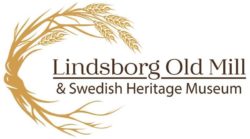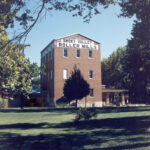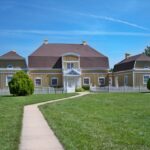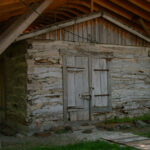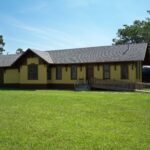Historic Buildings & Museum Exhibits
We recommend allowing at least 30 minutes for touring through the mill and an hour for visiting all museum attractions.
Please plan your arrival time accordingly to enjoy the full experience of the Lindsborg Old Mill & Swedish Heritage Museum before closing time at 5 p.m.
The Smoky Valley Roller Mill was built in 1898. Unlike a grist mill which uses stones, a roller mill uses a series of corrugated rollers to grind grain. This type of mill, known as “the grand daddy of the modern mill” became important in this area with the introduction of hard winter wheat in 1870s. The mill operated as a business until 1955, shipping flour across the U.S. and Europe.
The mill was originally water powered, utilizing turbines in the river. In the 1930s, the dam washed out. Fortunately, though, by this time, the owners of the mill had already installed electric power.
It took four to six people to operate the mill. At times it ran 24 hours a day. It processed 30-35 bushels of wheat per hour, which yielded 1,260 to 1,470 pounds of flour per hour.
Efforts to restore the mill to operating condition began in the 1960s and were completed in 1981. The National Register of Historic Places added the mill to their roster in 1972.
1872 Charles Johnson & C.R. Sundstrom operate first grist mill
1880 Flood waters damage mill
1882 J.G. Bergsten & Francis Johnson build second grist mill
1889 Grist mill converted to a modern roller mill
1890 Theo. Teichgraeber leases mill, adds steam power
1892 Theo. Teichgraeber purchases mill
1897 Mill burns down
1898 Present mill built by Teichgraeber
1903 Major flood damages property
1907 New dam installed. Mr. & Mrs. Teichgraeber pass away
1908 Sons Emil & Carl Teichgraeber operate mill
1910 Mr. & Mrs. William Hagstrom, Mr. & Mrs. Emmanuel Hagstrom purchase mill
1927 Mill closes for a time
1934 Runbeck brothers reopen mill
1930s Flood waters destroy dam
Mill operates with electrical power
1951 Kenneth & Edwin Johnson manage mill
1955 Mill closes
1962 Mill given to McPherson County
1974 George Tesarek begins restoration of mill machinery
1981 Restoration complete
Designed by Ferdinand Boberg, one of Sweden’s premier architects at the turn of the century, the Swedish Pavilion is the only one of Boberg’s international exposition buildings in existence today. It is the only example of his work in the United States. It is also one of very few international buildings remaining from the St. Louis World’s Fair. When the Swedish government would not authorize the funds, Boberg volunteered his services and the building was built by popular subscription in both Sweden and the United States. C.A. Swensson, president of Bethany College was the chairman of the Swedish-American building committee.
The building followed the design of the traditional Swedish Manor House or “herrgård” honoring the architectural past of Sweden. The Pavilion was prefabricated at Ekmans Construction Company in Sundbyberg just north of Stockholm, Sweden. It then was dismantled and shipped to the United States by boat, landing at the Port of Baltimore. The materials were then transported by train to the building site on the fairground arriving in late March of 1904. The Pavilion opened to visitors on May 9, 1904, and it showcased the best of Sweden at the Fair. The guest books show that it was a favorite gathering place for both Swedes and Swedish-Americans.
At the close of the Fair, the Swedish Pavilion was purchased by W.W. Thomas, U.S. Minister to Sweden and Norway, and presented to Bethany College in Lindsborg as a memorial to his friend Carl Swensson who had died very suddenly in February 1904. It served as a classroom for domestic sciences, library, museum and home to the art department for more than 60 years under Swedish born artist Birger Sandzén. Generations of students studied under Sandzén in this space and remember it fondly.
In 1969 the Swedish Pavilion was moved from Bethany College to the Old Mill Museum and a partial restoration was completed. The Pavilion is used for cultural heritage events several times throughout the year. The building was entered onto the National Register of Historic Places in 1973. In 1976 King Carl XVI Gustaf rededicated the building to all Swedes and Swedish-Americans.
Originally located southwest of Lindsborg, this home was one of the first above-ground structures in the area. Multiple families lived in the home and at least three children born inside.
By 1955 the cabin had deteriorated and was slated for demolition, but area resident Norman Malm stepped in to save it. About 1960, the McPherson Lions Club obtained ownership, moved it to Riverside Park, and renovated the weakened logs. Three years later, the Lions Club assisted with moving the cabin to museum grounds.
Ongoing weatherproofing and repairs became prohibitively expensive, so a volunteer committee completed a shelter structure in 2006 to protect the cabin from harsh Kansas weather.
“The Old Cabin”
By John Marshall
(The Lindsborg News-Record; September 15, 2022; Reproduced by permission)
In addition to the 1898 Flour Mill and the 1904 World’s Fair Swedish Pavilion, a number of other historic structures grace the museum grounds.
1903 West Kentuck One Room School – originally located between Lindsborg and McPherson
1879 Lindsborg’s Kansas Pacific/Union Pacific Railroad Depot – just a few blocks from original location
1879 Lindsborg School – First public school in Lindsborg, then first building at Bethany College
Ca 1890 Erickson Bros. Workshop – local farm workshop where brothers developed telephone dial technology
1869 Blacksmith Shop – originally located near Coronado Heights northwest of Lindsborg
1869 ‘Sweadal’, First County Courthouse – originally located southwest of Lindsborg
People from many backgrounds settled in McPherson County, Kansas. Yet, there is no doubt that the immigration of two large groups – the Swedes and the Mennonites- had a defining impact on our history. ‘Dreams of America’ explores their journeys to build new homes in a new land. They were not unlike other pioneers in some ways. Yet these two groups forged their own unique paths. With faith, courage and a strong sense of their own identity, they fulfilled their dreams and left an inspiring legacy.
